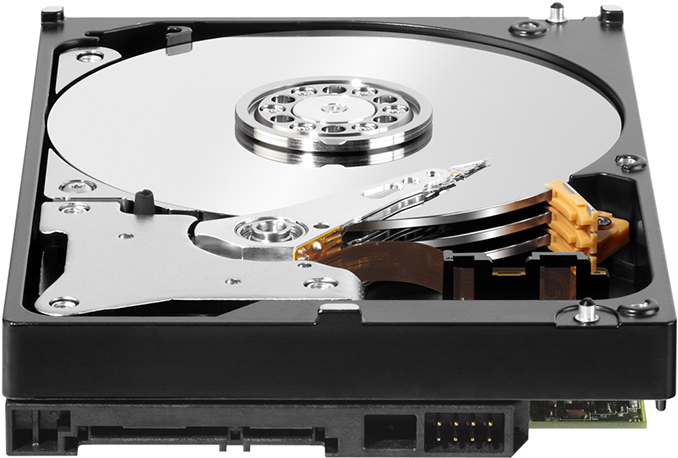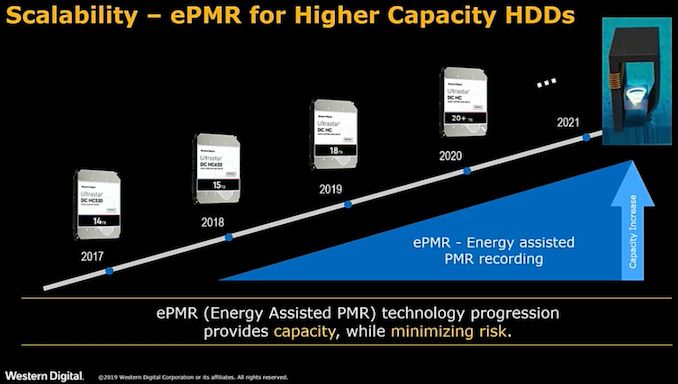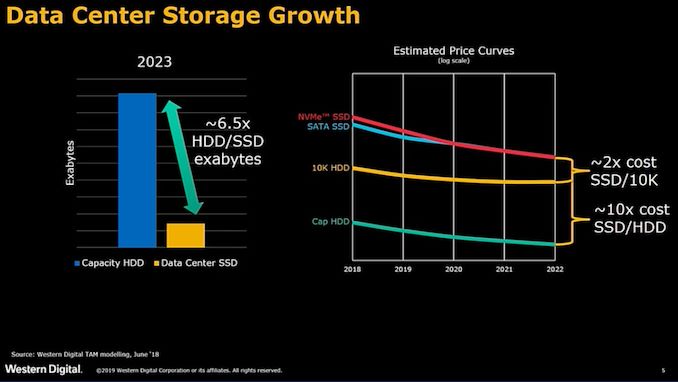Western Digital: Over Half of Data Center HDDs Will Use SMR by 2023
by Anton Shilov on March 19, 2019 10:30 AM EST- Posted in
- HDDs
- Storage
- Western Digital
- SMR
- MAMR

Western Digital said at OCP Global Summit last week that over half of hard drives for data centers will use shingled magnetic recording (SMR) technology in 2023. At present Western Digital is the only supplier of SMR HDDs managed by hosts, but the technology is gaining support by hardware, software, and applications.
SMR technology to boost capacity of hard drives fairly easily but at the cost of some performance trade-offs due to the read-modify-write cycle introduced by shingled tracks. Since operators of datacenters are interested in maximizing their storage capacities, they are inclined to invest in software that can mitigate peculiarities of SMR. As a result, several years after Western Digital introduced its first host-managed SMR HDDs, more and more companies are adopting them. Right now, the vast majority of datacenter hard drives are based on perpendicular magnetic recording technology, but WD states that in four years SMR HDDs will leave PMR drives behind.
Obviously, usage of SMR will not be the only method to increase capacities of hard drives. Energy-assisted PMR technologies (e.g., MAMR, HAMR, etc.) will also be used by Western Digital. In the coming quarters the company intends to release MAMR-based HDDs featuring a 16 TB (ePMR) and 18 TB (eSMR) capacity. The company also plans to introduce 20 TB HDDs in 2020.
High-capacity hard drives are not going to be replaced by high-capacity SSDs any time soon, according to Western Digital. HDDs will continue to cost significantly less than SSDs on per-TB basis. Therefore, they will be used to store 6.5 times more data than datacenter SSDs in 2023.
Related Reading:













33 Comments
View All Comments
fazalmajid - Tuesday, March 19, 2019 - link
I just paid $100 for a 1TB NVMe Intel 660P, and slightly over $200 for a 2TB one. Just how much cheaper do they need to be before you deign to ditch spinning rust?yankeeDDL - Wednesday, March 20, 2019 - link
Look at the announcement of HP's new Envy 360 (https://www.anandtech.com/show/14103/hp-reveals-en...Look at the disk size. And these are 700-800usd laptops: not entry level, for sure.
The awful displays are still here, and I don't see these horrendous 256GB SSD be gone anytime soon.
MDD1963 - Tuesday, March 26, 2019 - link
I wish 2 TB NVME drives had been that inexpensive 2 years ago when I bought my 500 GB 960 EVO for $250-ish....; that you can get a 2 TB Intel SSD for that much now is amazing...jabber - Wednesday, March 20, 2019 - link
You don't have to take that many photos or video on holiday either. Remember no one wants to see them. Digital has not been a improvement in this area.One roll of 36 35MM film per week was the deal back in the good old days. Some folks would even ask to look at them back then.
yankeeDDL - Thursday, March 21, 2019 - link
But that's not the point at all, is it? I can take a couple of 5 min videos and end up easily with 10GB. I can then edit it to my like, but still, till then, it will occupy a large portion of the SSD.My Windows folder clocks at 40GB, so out of 256GB you really get a bit over 200, once you install the basics. I find it unbelievable that 1/5th of your disk is not available from the get go.
mode_13h - Tuesday, March 19, 2019 - link
What about backups?Did you know that the cloud is used for more than just social networks? There's a lot of immutable or rarely-modified data in need of nearline storage.
PeachNCream - Tuesday, March 19, 2019 - link
No one is interested in +16TB of storage on a single drive. The "experts" said so already in regards to SSDs and we were plainly told that 8+TB on SATA is too slow to rebuild even on NAND so obviously doing the same with a mechanical drive is far worse so there is no market at all for more than 4TB of mechanical drive capacity.fazalmajid - Tuesday, March 19, 2019 - link
Those drives are not used as part of RAID arrays, but as part of cold-storage systems using erasure codes and the likePeachNCream - Wednesday, March 20, 2019 - link
Which drives? The SSDs in the previous article or the mechanical drives in this one? In either case, I think that it isn't possible to set limits on use by saying a particular storage device will or will not be used in an array. None of us are in a position to hover over ever data center's systems administration staff and slap their hand with a ruler when they start configuring RAID on a particular media type.MDD1963 - Tuesday, March 26, 2019 - link
I've had my 4 TB drive for about two years, and, until I did a Clonezilla image backup two weeks ago rocketing my total to 300 GB used, I had less than 40-50 GB worth of data on it....(Most everything truly important is in multiple cloud storage accounts anyway....) I almost wish I needed more drives so I could find an excuse to build and/or buy a NAS...